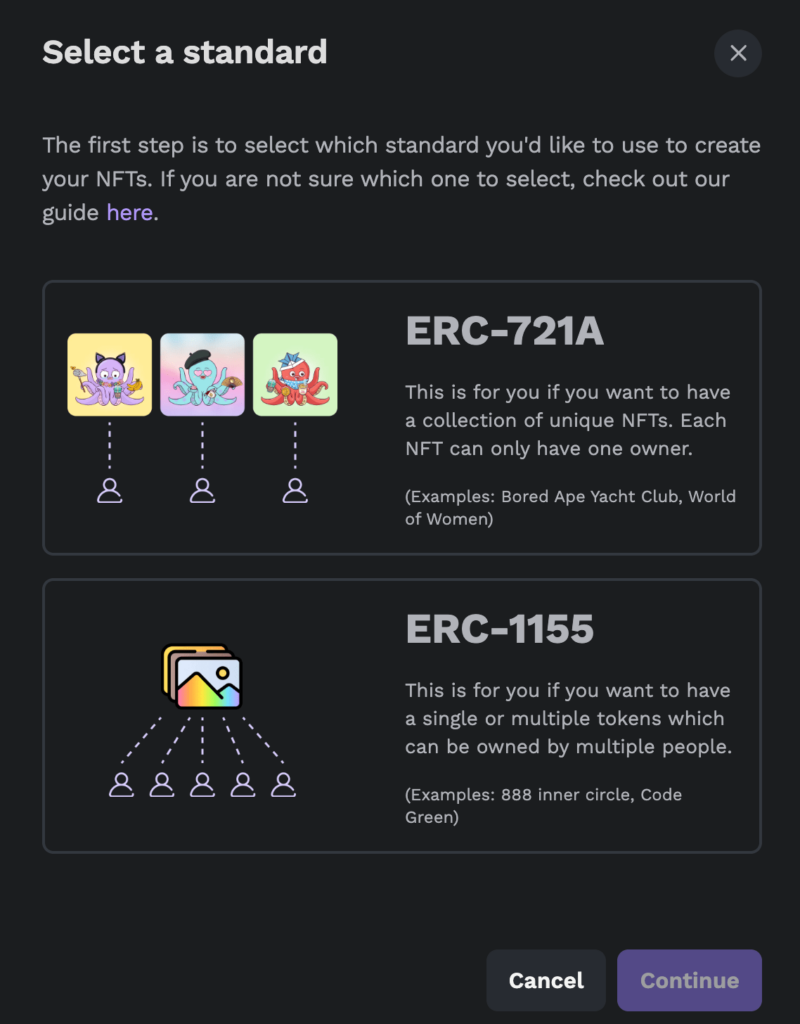The debate between ERC-721 vs ERC-1155 has been around since day one. It has left many creators wondering what’s the difference between them, and which they should use for their own collection.
Of these two standards, ERC-721 appeared on the scene first, with ERC-1155 following after, but with many unique properties.
In this article we’ll break down these two token standards for you. We’ll also explain what the newer, modified ERC-721A variant is. After comparing the unique properties of each, you’ll have everything you need to decide which standard serves you best.
ERC-721

Released in early 2018, ERC-721 is one of the most common token standards found in the space today. This is because every single NFT in an ERC-721 collection is unique and cannot be replicated; there are no two copies of the same NFT. ERC-721 was popularized by CryptoKitties, a NFT project by Dapper Labs. The CTO of Dapper Labs, Dieter Shirley, is also credited with the initial proposal for ERC-721.
The successful rise of ERC-721 can largely be attributed to its rapid use and adoption by NFT creators. Several years later, it remains the go-to token standard for nearly every PFP collection.
ERC-721A
Four years after ERC-721, new revision hit the scene: ERC-721A, released by the team behind the NFT collection, Azuki.
It’s important to note that ERC-721A is not actually a new token standard; rather, it’s just an extension or improved implementation of ERC-721. ERC-721A is marked by its significant gas-savings when it comes to batch minting (minting multiple NFTs in the same transaction). Since its release, ERC-721A has more or less become the default implementation of ERC-721 for projects.
At Launchpad, we use ERC-721A by default for all ERC-721 collections. This decision results in substantial cost savings. As already mentioned, for collectors, it means saving money when minting multiple NFTs at a time. But it also benefits creators, who may reserve and set aside a certain percentage of NFTs for themselves.
ERC-1155

ERC-1155 was created several months after ERC-721 and released about a year after its creation. It immediately began shaking things up in the space, thanks to a host of new abilities. Its development is credited to members of the teams behind Enjin, The Sandbox, and Horizon Games.
The main distinguishing feature that separates ERC-1155 from ERC-721 concerns their number of tokens. Unlike ERC-721, where there can only be copy of each token in a contract, ERC-1155 can support multiple copies of the exact same NFT in its contract. Furthermore, each token can have its own separate presale/public sale, token price, and token image.
Another advantage of ERC-1155 is its ability to support both fungible and non-fungible tokens on the same smart contract. This has many uses, and is especially beneficial for blockchain gaming: for example, with ERC-1155, unique NFTs can be earned and transferred to players, while also accepting in-game payments in the form of fungible tokens.
ERC-1155 also supports what is known as semi-fungible tokens. Semi-fungible tokens are those which can hold the properties of both fungible and non-fungible tokens during their lifetime. This means that while they may initially act like fungible tokens, (being indistinguishable from one another), they are generally swapped or redeemed at some point. This swap/redemption causes them to lose their initial properties, and become a non-fungible token. This makes them useful as tickets, vouchers, or anything that is required to change its state after being redeemed.
ERC-721 vs ERC-1155
There are a number of differences between these two token standards, some of which we mentioned above. As a quick this vs that comparison:
- ERC-721 supports the creation of non-fungible tokens; ERC-1155 may create fungible, non-fungible, or semi-fungible tokens.
- ERC-1155 allows for the batch transfers of tokens, which reduces transaction costs; ERC-721 tokens must be transferred individually.
- ERC-721 uses static metadata, stored directly on the smart contract for each token ID. Conversely, ERC-1155 contracts do not store additional metadata such as file names, and are linked to multiple URIs.
ERC-20 vs ERC-721 vs ERC-1155 vs ERC-721A:
An Easy Reference Chart
There are many ERC token standards in use today. There are even more in proposal for future use. But there are several token standards in particular that are everywhere in the space and are especially worth knowing.
Below is a reference chart of some of the most popular ERC token standards today. We’re including ERC-721A in this list as well for easy comparisons, although it is technically not its own standard.
| ERC Type | Description | Fungibility |
|---|---|---|
| ERC-20 | The most common standard for creating fungible cryptocurrencies on top of the Ethereum blockchain. Examples include: USDC, APE, SHIB. Created in 2015, and released in 2017. | Fungible |
| ERC-721 | The most common standard for creating non-fungible tokens (NFTs) on top of the Ethereum blockchain. Released in January, 2018. | Non-Fungible |
| ERC721A | A modification of ERC-721 made by the team behind Azuki. Notable for its ability to mint multiple NFTs in a single transaction with significantly reduced gas fees. Released in January, 2022. | Non-Fungible |
| ERC-1155 | A hybrid NFT standard which allows for fungible or non-fungible tokens, and batch transfer of tokens. Commonly used in NFTs and blockchain games. Created in June 2018, and released in June 2019. | Fungible, Non-Fungible, or “Semi-Fungible” |
Creating Your Own ERC-721A or ERC-1155 NFT Collection
With Launchpad, our NFT creator toolkit, it doesn’t matter if you’re making an ERC-721A or ERC-1155 NFT collection—we’ve got everything you need. A simple, guided flow makes the process of making your very own collection easy and rewarding.

While the process of making an ERC-721A or ERC-1155 may differ slightly, in both instances, we walk you through setting your collection name, symbol, preview image, token(s), payout and royalty addresses.
With HeyMint’s Launchpad, it’s never been easier to implement your idea and bring it to fruition. Try it out, and see for yourself how simple launching a collection can be!
So, when it comes to ERC-721 vs ERC-1155, which is better? The truth is that both have nearly limitless possibilities, as well as their own strengths and weaknesses. Ultimately, the best token standard is the one that is right for you, and right for the needs of your project.
Further Reading

How to Start an NFT Collection
How to Generate an NFT
The Ultimate Guide to Digital Collectibles
How to Make an NFT for Free
